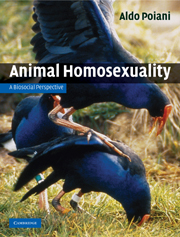Book contents
- Frontmatter
- Dedication
- Contents
- Contributors
- Acknowledgements
- Preface
- 1 Animal homosexuality in evolutionary perspective
- 2 The comparative study of homosexual behaviour
- 3 Genetics of homosexuality
- 4 Ontogenetic processes
- 5 The endocrine and nervous systems: a network of causality for homosexual behaviour
- 6 Immunology and homosexuality
- 7 Sexual segregation effects
- 8 The social, life history and ecological theatres of animal homosexual behaviour
- 9 Homosexual behaviour in primates
- 10 A Biosocial Model for the evolution and maintenance of homosexual behaviour in birds and mammals
- Appendix 1 Glossary
- Appendix 2 Predictions of the Synthetic Reproductive Skew Model of Homosexuality and results obtained in the comparative tests of the model carried out in birds and mammals
- Appendix 3 Comments on further results of comparative analyses of independent contrasts reported in the full correlation matrices of birds and mammals
- References
- Index
- Plates
Appendix 2 - Predictions of the Synthetic Reproductive Skew Model of Homosexuality and results obtained in the comparative tests of the model carried out in birds and mammals
Results Predicted
Published online by Cambridge University Press: 05 July 2014
- Frontmatter
- Dedication
- Contents
- Contributors
- Acknowledgements
- Preface
- 1 Animal homosexuality in evolutionary perspective
- 2 The comparative study of homosexual behaviour
- 3 Genetics of homosexuality
- 4 Ontogenetic processes
- 5 The endocrine and nervous systems: a network of causality for homosexual behaviour
- 6 Immunology and homosexuality
- 7 Sexual segregation effects
- 8 The social, life history and ecological theatres of animal homosexual behaviour
- 9 Homosexual behaviour in primates
- 10 A Biosocial Model for the evolution and maintenance of homosexual behaviour in birds and mammals
- Appendix 1 Glossary
- Appendix 2 Predictions of the Synthetic Reproductive Skew Model of Homosexuality and results obtained in the comparative tests of the model carried out in birds and mammals
- Appendix 3 Comments on further results of comparative analyses of independent contrasts reported in the full correlation matrices of birds and mammals
- References
- Index
- Plates
Summary
Prediction 1
Test a: Same-sex Mounting contrasts and Ecological Constraints contrasts are positively correlated.
Prediction 2
Test a: Same-sex Mounting contrasts are higher at intermediate values of Log-Social Unit Size contrasts.
Prediction 3
Test a: Relatedness contrasts are positively correlated with Affiliative Mount contrasts. (Affiliative Mounts are a specialised kind of same-sex mount.)
Test b: Relatedness contrasts are negatively correlated with Same-sex Mounting contrasts (inbreeding avoidance).
Prediction 4
Test a: Mating System contrasts are positively correlated with Same-sex Mounting contrasts.
Test b: Mating System contrasts are positively correlated with Plumage Sexual Dichromatism (in birds) and Body Mass Sexual Dimorphism (in mammals) contrasts. Note that empirical support for this prediction will also be an indirect test for the quality of our dataset, phylogenies and appropriateness of comparative analysis of independent contrasts. This is so because the association between polygamy and sexual dimorphism/dichromatism is already a well-established pattern from previous independent studies in both birds (see, for example, Dunn et al. 2001) and mammals (see, for example, Weckerley 1998).
Test c: Sex Involved contrasts (see Prediction 5, Test a) are positively correlated with Mating System contrasts. That is, F–F mounting would be more common in polygamous species.
- Type
- Chapter
- Information
- Animal HomosexualityA Biosocial Perspective, pp. 435 - 440Publisher: Cambridge University PressPrint publication year: 2010



